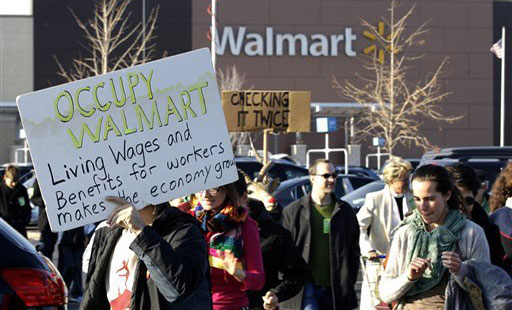
RAYMORE, Mo. – The temperature in Kansas City hovers around freezing as union activists from many different sectors come out on Black Friday to support Walmart workers’ fight for a living wage and a union. The first to pull into a parking lot adjacent to the Walmart in Raymore, Mo., is Billy Moffet, president of Communications Workers of America Local 6450, the most activist CWA local in Western Missouri. Stepping out of his extended cab pickup, Moffett pauses, slings a bullhorn over his shoulder, grabs a stack of handwritten signs, and crosses the street to take up position on the sidewalk adjacent to Walmart.
Wearing a red CWA shirt with the words of Dr. Martin Luther King, Jr., “I am a drum major for justice” on the front, Moffett says he is here this morning “to fight the largest company in the world paying poverty wages.” He points out that the struggle of Walmart workers for a living wage is a fight that is important to CWA, “because when we pick up our lowest paid workers, it lifts everyone up.”
Until Walmart starts paying its workers a wage they can live on, their profitability, says Moffett, “comes out of our pocket…. We’re paying millions of dollars in taxes to pay for public assistance to the largest company in the world.” All because Walmart refuses to “pay their workers properly so they don’t have to file for public assistance.” According to scholar Michele Swan, “Walmart takes one-half of the total food stamp system” in order to feed its workers. In Swan’s opinion, this makes Walmart, the “nation’s largest poverty incubator.”
Moffett is not the only one standing up to the retail giant the day after Thanksgiving: At over 1600 Walmart locations nationwide similar protests, pickets, and actions took place on Black Friday. These actions are designed to raise public awareness of the profound and pervasive suffering Walmart inflicts on its own employees in the name of profitability. Martha Sellers, a Walmart cashier for 11 years, has lost sixty pounds this year after the passing of her partner and the loss of their income. “That’s how many meals I’ve missed.” Last month, Sellers says, “I almost passed out at work and my manager asked me if I was hung over.” She wants to know, “How do you tell your manager that you’re hung over – from hunger, because he won’t give me enough hours?”
As more union activists make their way to the sidewalk bordering Walmart it is hard not to notice the diversity of the crowd. On this wind-chilled strip of concrete, differences in age, gender and race seem far less relevant than what unions they belong to. Suffice it to say that today’s crowd is not the “good old boys club” many associate with the union movement. In fact, women union workers significantly outnumber the men this morning. According to the Bureau of Labor Statistics, that’s not surprising: In 1983 there were 10.1 percent more men in unions than women, but by 2013 that gap had shrunk to 1.4 percent, a larger percentage of women in the union movement than ever before. The Coalition of Labor Union Women is literally flying their flag this Black Friday.
With the blue and white CLUW flag snapping in the wind off to her right, Antoinette Robinson, a U.S. postal worker and president of the CLUW Kansas City chapter, is here to support the Walmart workers. As the air around her crackles with the chant “hey hey, ho ho, poverty wages have got to go,” Robinson explains that the Walmart workers’ fight is very important to CLUW because “women are [Walmart] workers…and they deserve a fair wage.” Robinson concludes by summarizing the demand of organized labor into three words: “Workers. Deserve. More.”
The idea that all who work deserve more is not lost on Claude Rhone, a proud member of the Ironworkers, Local 10, Kansas City. A bearded man in a union hoodie, Rhone stands on the sidewalk holding a handwritten cardboard sign. Reinforced with duct tape, the sign reads, “Poverty Wages Keep Prices Low.” Though he’s the only member of the building trades present, Rhone knows which side he’s on: “The largest employer in the nation should be paying their employees a fair wage, a living wage.”
Cantare Davunt, a customer service manager, brings home about $322 a week. She knows what it’s like to work for the world’s largest employer and not be paid a living wage. In order to make ends meet, in the summer she doesn’t pay her electric bill. For her, Thanksgiving was “an unwelcome reminder of the fact that we can’t afford dinner.” She wonders, “How can we [have Thanksgiving] when we earn less than $20,000 a year?”
“Walmart is a bad deal for employees,” says Jessica Podhola. Braving the November morning in nothing more than shirt sleeves so that her International Union of Painters and Allied Trades T-shirt would not covered by a coat, Podhola continues, “Walmart is a bad deal for our economy, and it’s a bad deal for their customers.” A member of Local 820, she stands with fellow union painter David Cox from Local 2012. Both hold black signs with the image of an upraised fist; above it in bright, bold letters the signs proclaim Solidarity! Together they’re out to “show solidarity, because if one of us is not being paid what we’re worth and getting the benefits they deserve, it drags us all down.”
As Black Friday marked the start of this year’s holiday shopping season, each of these union activists reflected on what they would get Walmart workers this year if they could get them anything in the world. Each one, from postal worker to painter, says the same thing: “$15 and a union.” These Kansas City union veterans know it takes more than wishes for workers to get respect. They have to organize and fight. In Kansas City the public support from these unions is a powerful sign to those who work inside: We are with you, you do not fight alone!
Photo: AP










